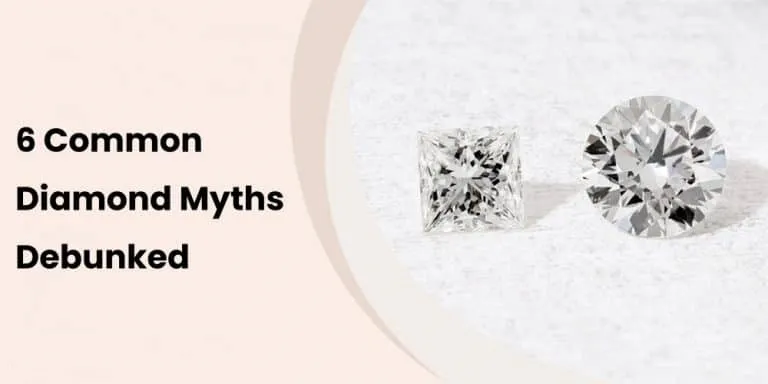Myth #1- Diamonds are Expensive
The most common myth, people do not understand is that diamonds come in various price points. Many people hesitate to go to the diamond store for this very reason. Each diamond is priced differently based on its internal 4C characteristics of Cut, Color, Clarity, and Carat weight. You can get a diamond with the same glamorous look as celebrities for a much better price. For this, you can cut corners yet get a desirable diamond for your diamond engagement ring. For instance, you do not necessarily need a 0.75-carat diamond, you can go for a cheaper 0.70-carat diamond with the same sparkle and glow as you would get in the 0.75-carat diamond. The resultant difference will not matter much as it would look the same on any diamond ring.
Myth #2- All Diamonds are the Same
People do not realize that each diamond is unique, having its own share of inclusions and blemishes. No two mined diamonds are the same as each of them has some of the other inclusions or color differences which are only visible under a microscope. For this, they are given a grade based on their Cut, Clarity, and Color. Finally, the diamond’s carat weight makes a big difference in its pricing, as we saw in the example above.
Myth #3-All Diamonds are White
Though most diamonds are white, there are rare colored diamonds available too. These include yellow diamonds, pink diamonds, green diamonds, and so on. One thing to note though, we are not talking about similar colored semi-precious gemstones- these are real diamonds in their truest form. Also called fancy color diamonds, these diamonds have a grade of their own. In fact, very slight color differences can make a big price difference. While yellow diamonds come in various color saturations, other colored diamonds like blue, pink or green are extremely rare. So much so, they are auctioned for the best price.
There are so many similar colored diamonds available in the market at lower prices that people do not usually take them seriously. In fact, jewelry appraisers in Denver and elsewhere routinely get antique jewelry from bounty-hunters trying their luck to become rich by selling antique colored diamond-encrusted jewelry.
Myth #4 – Diamonds are Indestructible
Diamonds are made of carbon, just like graphite, graphene, and other carbon-based materials. The main difference is that diamonds are bonded differently, making them long-lasting. We wouldn’t say diamonds are indestructible, like other carbon-based materials diamonds do degrade to graphite eventually. However, this process is so slow that a diamond can last billions of years in the same form. It would be safe to say diamonds are long-lasting, at least for us.
Myth #5- All Diamonds are Mined
Since the 1950s, diamonds have been produced in a lab setting mimicking the way they were found deep in the earth’s crust. There are two distinct ways to do this- High-Pressure High Temperature (HPHT) process and Chemical Vapor Deposition (CVD) diamond.
In the HPHT process, a source of carbon (typically graphite) is used as a seed along with a metal solvent and subjected to an environment that mimics the way diamonds are produced about 100 miles in the Earth’s crust. CVD, on the other hand, is the process where a diamond crystal is subjected to high pressure and temperature above 2000°C. Such conditions result in thermal dissociation of hydrogen which eventually results in high-quality diamonds
In the HPHT process, a source of carbon (typically graphite) is used as a seed along with a metal solvent and subjected to an environment that mimics the way diamonds are produced about 100 miles in the Earth’s crust. CVD, on the other hand, is the process where a diamond crystal is subjected to high pressure and temperature above 2000°C. Such conditions result in thermal dissociation of hydrogen which eventually results in high-quality diamonds
To the naked eye, no one would be able to spot the difference between lab-grown diamonds and natural diamonds. In fact, even experts would need high-end equipment to tell which is which. These lab-grown diamonds are almost 40 percent cheaper than mined diamonds. Many jewelers prefer using these as a viable alternative to mined diamonds.
Related Read : Lab Grown Diamonds Vs Natural Diamonds.
Myth #6- Diamonds Cannot Chip Or Brea
Yes, diamonds are the hardest materials on earth, but that doesn’t mean they cannot be chipped or broken. Once a diamond has been cut, there are chances it can chip away when pressure is applied or when it is bumped to another surface. To protect them from this, diamonds are carefully protected by the settings (design) of the jewelry.
A Few Last Words
Diamonds have fascinated mankind for ages. So much so, diamond engagement rings are considered the best gift to ask for one’s hand in marriage. There are diamonds available that suit every pocket, all you need to do is to find the right jeweler who’d help you choose the right one.
Are you looking for the right jeweler to buy Diamonds in Denver? Get a consultation from our experts now!
Also read for more "How Is A Diamond Cut & Polished?"

